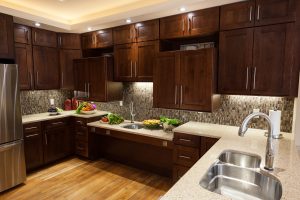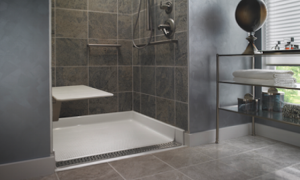When it comes to an aging population, smart design is often a function of planning ahead.
By Dianne M. Pogoda
The U.S. population is aging at a rapid rate: from now through 2036, 10,000 people will celebrate their 65th birthday every day. And while “60 might be the new 50,” and many of us are aging more healthily and in better shape than a few generations ago, there are still certain physical realities of growing older that design can accommodate.
While many seniors may downsize after their kids move out, seek a single-story dwelling for easier movement, or move to a “55-plus” community for lower taxes, age-appropriate conveniences and amenities, there’s still a large percentage who choose to stay in the home in which they raised their family, and remain in a community that’s familiar.
Enter the principles of Universal Design, applied to living spaces.
To make the familiar more accessible to the needs of seniors — or indeed, to anyone regardless of physical abilities — guidelines are in place that aim to keep the residential environment safe. (These differ from the requirements of the Americans with Disabilities Act, which concerns non-residential spaces.) The trick is to marry safe with beautiful, without an institutional ambience. This is particularly important in the kitchen and bath — where there is increased hazard for potential accidents, owing to water and spills, or hot surfaces.

It’s a big market, and growing exponentially. In July 2015, according to the U.S. Census Bureau, there were nearly 48 million individuals in the U.S. age 65 or over, accounting for about 15 percent of the population. By 2060, that number will more than double, to about 98 million — and nearly 20 million will be 85 or older.
It’s a big market in terms of dollars and cents, too. Americans spend some $30 billion on changes to their homes to accommodate aging in place each year, and expenditures by homeowners age 55 and over are expected to grow by nearly 33% by 2025. This accounts for more than three-quarters of total gains over the decade. The share of market spending by homeowners age 55 and over is projected to reach 56% by 2025, up from 31% in 2005, according to the Joint Center for Housing Studies of Harvard University.
And it’s not just about the aging population: The U.S. Centers for Disease Control estimate that roughly 20 percent of Americans have some physical limitation or disability, making design principles pertaining to accessibility important for an even broader swath of the population. It’s truly an inter-professional discipline, incorporating designers, builders and occupational therapists to maximize performance of the products and efficiency of the design.
Remodeling spaces to accommodate the needs of seniors or physically challenged individuals also includes a tremendous psychological component. Designers need to consider emotional factors, and one of the most important tools they can employ, according to Paula Kennedy, CMKBD, CLIPP, is empathy.
“Listen to what the clients don’t say,” she advises. “Dig deep into the deconstruction phase of the information-gathering process with them, read between the lines, be a sleuth in their home to catch cues. For instance, reading glasses, a remote control with large buttons or numbers on it, and other clues can be found on a walk-through of their home. Also, talk with caregivers about specific needs. And this type of design needs to be flexible, because we are creating solutions and supports for current situations and for the future.”
Kennedy says the most frequently asked questions center on cost, whether a space will “look like a hospital,” and how it will affect resale values.
“Honestly, I no longer get resistance from clients who think they aren’t old enough to think about such things,” she says. “The clients I get in their 50’s and 60’s watched their parents go through needing the solutions we offer, and they may even have had some physical limitations themselves. I always use my skiing story, when I fell and sprained my ankle badly. At age 45, I really needed grab bars!”
Erik Listou and Louis Delaware, co-founders of the Living in Place Institute — each of whom holds Certified Living in Place Professional designation, among others — established guidelines and curriculum requirements for designers to earn CLIPP certification, to improve accessibility and safety in all homes.
Listou explains that one of the biggest obstacles in this area of design is the perception held by clients.
“No one likes to think of themselves as ‘aging,’” he emphasizes. “From a designer’s perspective, the pushback is minimized when we use examples to talk about other people’s needs. Pushback comes when we talk about the people in the house. And really, the people are not our focus — the house is. Safety and accessibility can’t be left up to the homeowner — they don’t know what they need, or what they might need. Current individual requirements may vary, but Living in Place design will accommodate the widest range of needs for anyone, now and in the future. We have a responsibility to provide the best possible design and take into account issues the consumer doesn’t even know about.”
Elle H-Millard, CKD, NKBA’s industry relations manager and resident designer, notes, “The biggest challenge in creating a space that people of all ages can live in is ensuring that it doesn’t have an institutional aesthetic. Designing with comfort and safety in mind is simply good design, and making it look good is where the designer’s creativity comes into play.”

For instance, Millard offers that grab bars are among those necessities that can often make a bath look institutional. When incorporated into a towel bar or shelving unit, however, the space takes on a new look and feeling.
“Something as simple as a lever door handle makes a space more user-friendly and appealing to people of all ages,” she adds. “Gripping a knob is much more difficult than gripping a lever handle.
“Lighting is another area in the kitchen and bath that can make a tremendous difference for people of all ages,” she observes. “Stop and think about how many people take their eyeglasses off while showering, and how additional lighting would improve visibility in a wet, slippery space.”
Solutions need not be terribly complex or expensive. The trick can often be planning ahead.
In the bathroom, Kennedy advises simple considerations:
- Installing extra backing behind shower tile for the future need for a grab bar.
- Make the water closet wide enough to allow future caregivers to help, and use a pocket door for easier access with a wheelchair, walker or cane.
- Fold-down benches in the shower allow flexibility of use.
- Always consider a caregiver’s presence in the spaces as well.
Kennedy notes that temperature controls, including radiant floor heating, can be a real life-changer for people whose circulation might be changing or who are sensitive to the heat or cold. Conversely, a great room with a cathedral ceiling can be a terrific layout for many families, but such large spaces don’t allow for good temperature control, or sound dampening, for that matter.
Visual cues can take on increased importance in design for seniors or anyone with balance or vision challenges, Listou says.
“For example, a client didn’t know why we incorporated a horizontal stripe into the tile design in the shower,” he recalls. “It was to give better depth perception.
“Similarly, in choosing colors, contrast plays different roles in different places. With flooring, for instance, designers should choose low contrast. The reason is that with a high-contrast pattern, a dark spot or design on a light floor can register as a hole if someone’s vision is compromised, and it can lead to a fall. Conversely, high contrast on a countertop can help people distinguish surfaces better, so in this application, high contrast works.”
He adds that sheen on surfaces can affect sight, too, like a light shining in the eyes. So, on countertops, for example, duller, matte or honed granite surfaces work well. “But the trick is not to talk about the surface as way to aid vision,” he says. “You talk about the beauty of the surface as an element of design.”
Ultimately, the designers concur that the challenge is to make these practical applications aesthetically pleasing — not institutional. Use wood – teak or mahogany – and install it like a ballet bar through a bathroom. This avoids the look of steel grab bars. And, the designers advise, give the rooms some color — that is a sure way to avoid an institutional environment.
“In the kitchen, we need to figure out cabinet heights, but this is based on individual clients’ needs,” Listou notes. “It’s different for a person who is able to stand and reach, vs. a person in a wheelchair. Make things reachable: We employ an “eyes-to-thighs” principle – nothing should be placed above the level of the eyes, or below the level of the thighs. Lower cabinets should contain things used more often.”
Lighting is also key. Leading technologies include sensors for motion and heat detection and voice recognition. The temperature and color of lighting can also be adjusted. And all these controls, as well as other home systems, can be connected to home assistants, like Amazon’s Alexa or Echo, or Google Assistant, or a smart phone app. This allows a resident to turn lights on or off or adjust brightness, or perform a whole range of functions by voice command, like deadbolt operation, doorbell view, operating the garage door opener, responding to a water sensor in the basement, adjusting window blinds, and more.
New features that are more of a luxury in today’s market include the smart toilet, says Millard, which helps reduce infections with bidet functions; adds light to dark areas; is self-cleaning, thus reducing the amount of chemicals used in the home, and is soothing with its warming features.
Just as it happened with cell phones, personal computers and smart phones, as the market for these products grows and prices come down, they will become standard features in more homes. It’s smart thinking to use an NKBA member/ certified designer to ensure that your remodeling and design professionals are familiar with the latest technologies and the best way to use them, not just in the home of the future, but in the home best suited to your future.








